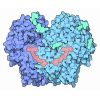[English] 日本語
 Yorodumi
Yorodumi- PDB-1cru: SOLUBLE QUINOPROTEIN GLUCOSE DEHYDROGENASE FROM ACINETOBACTER CAL... -
+ Open data
Open data
- Basic information
Basic information
| Entry | Database: PDB / ID: 1cru | ||||||
|---|---|---|---|---|---|---|---|
| Title | SOLUBLE QUINOPROTEIN GLUCOSE DEHYDROGENASE FROM ACINETOBACTER CALCOACETICUS IN COMPLEX WITH PQQ AND METHYLHYDRAZINE | ||||||
 Components Components | PROTEIN (SOLUBLE QUINOPROTEIN GLUCOSE DEHYDROGENASE) | ||||||
 Keywords Keywords | OXIDOREDUCTASE / BETA-PROPELLER / SUPERBARREL / COMPLEX WITH THE COFACTOR PQQ AND THE INHIBITOR METHYLHYDRAZINE | ||||||
| Function / homology |  Function and homology information Function and homology informationglucose 1-dehydrogenase (PQQ, quinone) / quinoprotein glucose dehydrogenase activity / metal ion binding Similarity search - Function | ||||||
| Biological species |  Acinetobacter calcoaceticus (bacteria) Acinetobacter calcoaceticus (bacteria) | ||||||
| Method |  X-RAY DIFFRACTION / X-RAY DIFFRACTION /  SYNCHROTRON / Resolution: 1.5 Å SYNCHROTRON / Resolution: 1.5 Å | ||||||
 Authors Authors | Oubrie, A. / Rozeboom, H.J. / Dijkstra, B.W. | ||||||
 Citation Citation |  Journal: Proc.Natl.Acad.Sci.USA / Year: 1999 Journal: Proc.Natl.Acad.Sci.USA / Year: 1999Title: Active-site structure of the soluble quinoprotein glucose dehydrogenase complexed with methylhydrazine: a covalent cofactor-inhibitor complex. Authors: Oubrie, A. / Rozeboom, H.J. / Dijkstra, B.W. #1:  Journal: J.Mol.Biol. / Year: 1999 Journal: J.Mol.Biol. / Year: 1999Title: The 1.7 Angstrom Crystal Structure of the Apo-Form of the Soluble Quinoprotein Glucose Dehydrogenase from Acinetobacter Calcoaceticus Reveals a Novel Internal Sequence Repeat Authors: Oubrie, A. / Rozeboom, H.J. / Kalk, K.H. / Duine, J.A. / Dijkstra, B.W. #2:  Journal: To be Published Journal: To be PublishedTitle: Structure and Mechanism of Soluble Quinoprotein Glucose Dehydrogenase Authors: Oubrie, A. / Rozeboom, H.J. / Kalk, K.H. / Olsthoorn, A.J.J. / Duine, J.A. / Dijsktra, B.W. | ||||||
| History |
|
- Structure visualization
Structure visualization
| Structure viewer | Molecule:  Molmil Molmil Jmol/JSmol Jmol/JSmol |
|---|
- Downloads & links
Downloads & links
- Download
Download
| PDBx/mmCIF format |  1cru.cif.gz 1cru.cif.gz | 209.7 KB | Display |  PDBx/mmCIF format PDBx/mmCIF format |
|---|---|---|---|---|
| PDB format |  pdb1cru.ent.gz pdb1cru.ent.gz | 164.5 KB | Display |  PDB format PDB format |
| PDBx/mmJSON format |  1cru.json.gz 1cru.json.gz | Tree view |  PDBx/mmJSON format PDBx/mmJSON format | |
| Others |  Other downloads Other downloads |
-Validation report
| Arichive directory |  https://data.pdbj.org/pub/pdb/validation_reports/cr/1cru https://data.pdbj.org/pub/pdb/validation_reports/cr/1cru ftp://data.pdbj.org/pub/pdb/validation_reports/cr/1cru ftp://data.pdbj.org/pub/pdb/validation_reports/cr/1cru | HTTPS FTP |
|---|
-Related structure data
| Related structure data | |
|---|---|
| Similar structure data |
- Links
Links
- Assembly
Assembly
| Deposited unit | 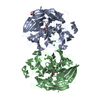
| ||||||||
|---|---|---|---|---|---|---|---|---|---|
| 1 |
| ||||||||
| Unit cell |
|
- Components
Components
-Protein , 1 types, 2 molecules AB
| #1: Protein | Mass: 50293.207 Da / Num. of mol.: 2 Source method: isolated from a genetically manipulated source Source: (gene. exp.)  Acinetobacter calcoaceticus (bacteria) / Cellular location: PERIPLASM / Production host: Acinetobacter calcoaceticus (bacteria) / Cellular location: PERIPLASM / Production host:  |
|---|
-Non-polymers , 5 types, 902 molecules 
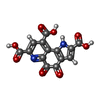
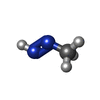






| #2: Chemical | ChemComp-CA / #3: Chemical | #4: Chemical | #5: Chemical | ChemComp-GOL / | #6: Water | ChemComp-HOH / | |
|---|
-Details
| Has protein modification | Y |
|---|
-Experimental details
-Experiment
| Experiment | Method:  X-RAY DIFFRACTION / Number of used crystals: 1 X-RAY DIFFRACTION / Number of used crystals: 1 |
|---|
- Sample preparation
Sample preparation
| Crystal | Density Matthews: 2.3 Å3/Da / Density % sol: 46.64 % | ||||||||||||||||||||||||||||||||||||||||||||||||||||||
|---|---|---|---|---|---|---|---|---|---|---|---|---|---|---|---|---|---|---|---|---|---|---|---|---|---|---|---|---|---|---|---|---|---|---|---|---|---|---|---|---|---|---|---|---|---|---|---|---|---|---|---|---|---|---|---|
| Crystal grow | Temperature: 293 K / Method: vapor diffusion, hanging drop / pH: 9.2 Details: PEG 6000, SODIUM CHLORIDE, CALCIUM CHLORIDE, TRIS, GLYCINE, pH 9.2, VAPOR DIFFUSION, HANGING DROP, temperature 293K | ||||||||||||||||||||||||||||||||||||||||||||||||||||||
| Crystal grow | *PLUS Method: vapor diffusion / Details: Oubrie, A., (1999) J.Mol.Biol., 289, 319. | ||||||||||||||||||||||||||||||||||||||||||||||||||||||
| Components of the solutions | *PLUS
|
-Data collection
| Diffraction | Mean temperature: 100 K |
|---|---|
| Diffraction source | Source:  SYNCHROTRON / Site: SYNCHROTRON / Site:  ESRF ESRF  / Beamline: ID14-3 / Wavelength: 0.9475 / Beamline: ID14-3 / Wavelength: 0.9475 |
| Detector | Type: MARRESEARCH / Detector: CCD / Date: Apr 5, 1998 |
| Radiation | Protocol: SINGLE WAVELENGTH / Monochromatic (M) / Laue (L): M / Scattering type: x-ray |
| Radiation wavelength | Wavelength: 0.9475 Å / Relative weight: 1 |
| Reflection | Resolution: 1.5→100 Å / Num. obs: 142076 / % possible obs: 97.8 % / Observed criterion σ(I): 0 / Redundancy: 4.1 % / Biso Wilson estimate: 16.8 Å2 / Rmerge(I) obs: 0.034 / Net I/σ(I): 30.2 |
| Reflection shell | Resolution: 1.5→1.53 Å / Redundancy: 2.8 % / Rmerge(I) obs: 0.34 / % possible all: 91.2 |
| Reflection | *PLUS Num. measured all: 580379 |
| Reflection shell | *PLUS % possible obs: 91.2 % |
- Processing
Processing
| Software |
| ||||||||||||||||||||||||
|---|---|---|---|---|---|---|---|---|---|---|---|---|---|---|---|---|---|---|---|---|---|---|---|---|---|
| Refinement | Resolution: 1.5→20 Å / σ(F): 0
| ||||||||||||||||||||||||
| Refinement step | Cycle: LAST / Resolution: 1.5→20 Å
| ||||||||||||||||||||||||
| Software | *PLUS Name: 'REFMAC+X-PLOR3.843' / Classification: refinement | ||||||||||||||||||||||||
| Refine LS restraints | *PLUS
|
 Movie
Movie Controller
Controller


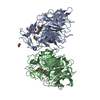
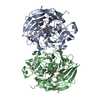



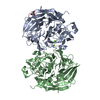
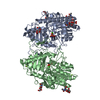
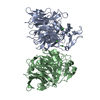
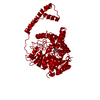
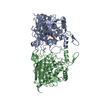
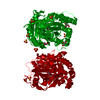

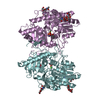
 PDBj
PDBj